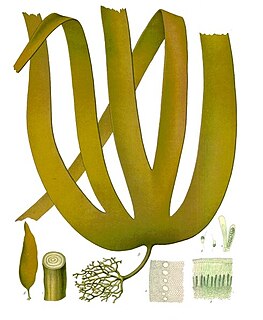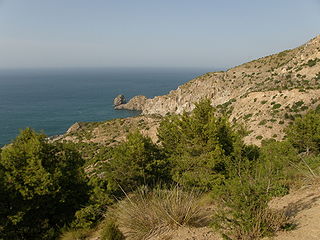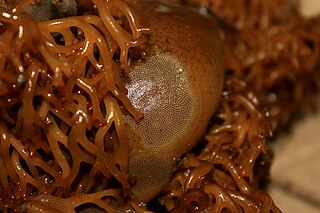
Alternation of generations is the type of life cycle that occurs in those plants and algae in the Archaeplastida and the Heterokontophyta that have distinct haploid sexual and diploid asexual stages. In these groups, a multicellular haploid gametophyte with n chromosomes alternates with a multicellular diploid sporophyte with 2n chromosomes, made up of n pairs. A mature sporophyte produces haploid spores by meiosis, a process which reduces the number of chromosomes to half, from 2n to n.

Kelps are large brown algae seaweeds that make up the order Laminariales. There are about 30 different genera. Despite its appearance, kelp is not a plant; it is a heterokont.

The brown algae, comprising the class Phaeophyceae, are a large group of multicellular algae, including many seaweeds located in colder waters within the Northern Hemisphere. Most brown algae live in marine environments, where they play an important role both as food and as a potential habitat. For instance, Macrocystis, a kelp of the order Laminariales, may reach 60 m (200 ft) in length and forms prominent underwater kelp forests. Kelp forests like these contain a high level of biodiversity. Another example is Sargassum, which creates unique floating mats of seaweed in the tropical waters of the Sargasso Sea that serve as the habitats for many species. Many brown algae, such as members of the order Fucales, commonly grow along rocky seashores. Some members of the class, such as kelps, are used by humans as food.

Laminaria is a genus of brown seaweed in the order Laminariales (kelp), comprising 31 species native to the north Atlantic and northern Pacific Oceans. This economically important genus is characterized by long, leathery laminae and relatively large size. Some species are called Devil's apron, due to their shape, or sea colander, due to the perforations present on the lamina. Others are referred to as tangle. Laminaria form a habitat for many fish and invertebrates.

Macrocystis is a monospecific genus of kelp. This genus contains the largest of all the phaeophyceae or brown algae. Macrocystis has pneumatocysts at the base of its blades. Sporophytes are perennial and the individual may live for up to three years; stipes/fronds within a whole individual undergo senescence, where each frond may persist for approximately 100 days. The genus is found widely in subtropical, temperate, and sub-Antarctic oceans of the Southern Hemisphere and in the northeast Pacific from Baja California to Sitka, Alaska. Macrocystis is often a major component of temperate kelp forests.

Saccharina is a genus of 24 species of Phaeophyceae. It is found in the north Atlantic Ocean and the northern Pacific Ocean at depths from 8 m to 30 m.

Alaria is a genus of brown alga (Phaeophyceae) comprising approximately 17 species. Members of the genus are dried and eaten as a food in Western Europe, China, Korea, Japan, and South America. Distribution of the genus is a marker for climate change, as it relates to oceanic temperatures.

Al Hoceima National Park is a national park located outside the town of Al Hoceima in Morocco. It covers an area of 480 km2 (185 sq mi), including 196 km2 (76 sq mi) of sea. The park was created in 2004 and is managed by the Haut-Commissariat des eaux et forêts et de la lutte contre la désertification.

Macrocystis pyrifera, commonly known as giant kelp or giant bladder kelp, is a species of kelp, and one of four species in the genus Macrocystis. Despite its appearance, it is not a plant; it is a heterokont. Giant kelp is common along the coast of the western Pacific Ocean, from Baja California north to southeast Alaska, and is also found in the southern oceans near South America, South Africa, Australia, and New Zealand. Individual algae may grow to more than 45 metres long at a rate of as much as 60 cm (2 ft) per day. Giant kelp grows in dense stands known as kelp forests, which are home to many marine animals that depend on the algae for food or shelter. The primary commercial product obtained from giant kelp is alginate, but humans also harvest this species on a limited basis for use directly as food, as it is rich in iodine, potassium, and other minerals. It can be used in cooking in many of the ways other sea vegetables are used, and particularly serves to add flavor to bean dishes.

The hydrology of the Strait of Messina accommodates a variety of populations of marine organisms. The intense currents and characteristic chemistry of the waters of the Strait determine an extraordinary biocoenosis in the Mediterranean Sea with a high abundance and diversity of species; the Strait of Messina, therefore constitutes an area of fundamental importance for biodiversity. Intense and alternate currents, the low temperature and an abundance of transported nitrogen and phosphorus transported to the surface from deep waters supports both pelagic and coastal benthic populations in a cycle of organic substance.
Pterygophora californica is a large species of kelp, commonly known as stalked kelp. It is the only species in its genus Pterygophora. It grows in shallow water on the Pacific coast of North America where it forms part of a biodiverse community in a "kelp forest". It is sometimes also referred to as woody-stemmed kelp, walking kelp, or winged kelp.

Laminaria hyperborea is a species of large brown alga, a kelp in the family Laminariaceae, also known by the common names of tangle and cuvie. It is found in the sublittoral zone of the northern Atlantic Ocean. A variety, Laminaria hyperborea f. cucullata is known from more wave sheltered areas in Scandinavia.

Aquaculture of giant kelp, Macrocystis pyrifera, is the cultivation of kelp for uses such as food, dietary supplements or potash. Giant kelp contains compounds such as iodine, potassium, other minerals vitamins and carbohydrates.

Cordylecladia erecta is a species of red algae in the family Rhodymeniaceae. It is found in the north east Atlantic Ocean and the Mediterranean Sea and is the type species of the genus.

Macrocystis integrifolia is one of four species of kelp in the genus Macrocystis which grows to about 6 metres (20 ft) long.
Lessonia trabeculata is a species of kelp, a brown alga in the genus Lessonia. It grows subtidally off the coasts of Peru and northern and central Chile, with the closely related Lessonia nigrescens tending to form a separate zone intertidally.
Laminaria ochroleuca is a large kelp, an alga in the order Laminariales. They are commonly known as golden kelp, due to their blade colouration, distinguishing them from Laminaria hyperborea

Phyllariaceae is a family of brown algae in the order Tilopteridales.
Phyllariopsis purpurascens is a species of large brown algae, found in the subtidal zone of the Mediterranean Sea and the intertidal zone of Morocco, as observed by Lourenço et al. (2020). While it is functionally similar to kelp species, it is not in the order Laminariales.
Pleurophycus gardneri is a species of brown alga. It is a deciduous kelp, primarily found in lower, rocky inter-tidal and shallow, rocky sub-tidal locations and is one of the most abundant kelps found within the Pleurophycus Zone. It is not commonly present deeper in the ocean than 30m and is considered a stipitate kelp. P. gardneri forms aggregates of densities up to 10m−2. These kelp beds reside below giant kelp forests, and were therefore often overlooked by researchers for many years. This kelp has a range from Central California to British Columbia, Canada, with a lifespan of only 3 – 6 years.














